#Ulugh Beg Madrasah
Explore tagged Tumblr posts
Video
Registan. Samarkand, Uzbekistan by Caspar Tromp Via Flickr: The Registan is the historical heart of Samarkand and has remained its main square throughout the centuries. The first madrasah was built under the grandson of the infamous Amir Timur (Tamerlane), named Ulugh Beg (1417-1420). Unlike his grandfather, Ulugh Beg was more interestes in arts and science than military conquest. The other two madrasahs, the Sher-Dor and Tilya-Kori, were built in the 17th century after some other Timurid monuments fell into disrepair. Together, all three madrasahs form a magnificent cityscape.
#Uzbekistan#O'zbekiston#Central#Asia#Art#Architecture#Film#Analogue#Analog#Analoog#Photography#35mm#Minolta#X700#Vintage#City#Urban#May#2023#Spring#Samarkand#Registan#Islamic#'Muslim#Late#Medieval#Tiles#Azulejos#flickr
1 note
·
View note
Photo

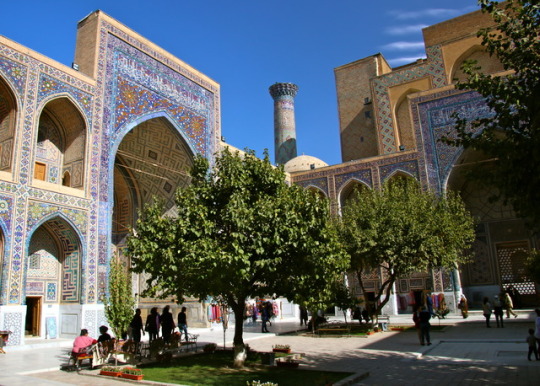


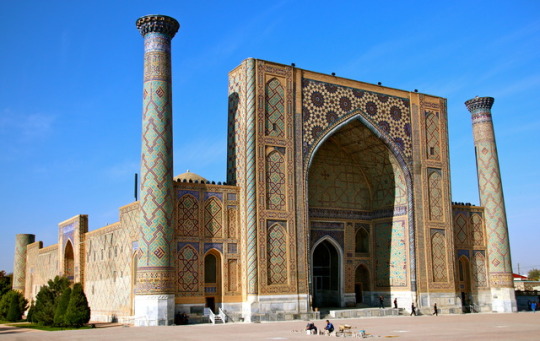


Samarqand - Usbekistan
Registan - Ulugh Beg Madrasah
#registan samarkand#registan#ulugh beg#ulughbeg#madrasah#madrasa#samarkand#samarquand#samarkanda#samarqand#silk road#on the silk road#silk road travel#silk road photo#silk road photograph#uzbekistan#uzbekistan photo#uzbekistan photography#uzbekistan travel#uzbekistan trip#around the world#world travel#jedwabny szlak#szlak jedwabny#central asia#azja centralna#beautiful#oriental#oriental architecture#architekturfotografie
6 notes
·
View notes
Photo

Yesterday, I dreamt of Uzbekistan. I didn't see any of these magnificent architecture, but it was magical enough to feel and know I was there. I could remember every detail, but I think it's meant to be private this time. So... Ulugh Beg Madrasa (Islamic school) stands in the historic centre of Samarkand, a UNESCO World Heritage Site. Together with other monuments, it forms the monumental ensemble of Registan, the old heart of the city. It was built between 1417 and 1421 by the then-Timurid governor of Samarkand, Ulugh Beg, Timur's grandson, and prominent astronomer, who was later emperor between 1447 and 1449. My favourite is the last pic. It's one of the entrances. How amazingly meticulous is that work of art?! Uzbekistan is really a magical place. Please visit before tour groups from those big countries come. #2019 #registan #samarkand #uzbekistan #centralasia #madrasah #traveladdict #wishlist #bucketlist #travelingtheworld #world #bestplacestogo #beautifuldestinations #dreamplaces #speechlessplaces #girlswhowander #glt #gltLove #girlslovetravel #unesco #neverstopexploring #wanderlust #travelUzbekistan #lelsinsamarkand #lelsinuzbekistan (at Ulugbek, Samarqand, Uzbekistan) https://www.instagram.com/p/CmcAki-hk2S/?igshid=NGJjMDIxMWI=
#2019#registan#samarkand#uzbekistan#centralasia#madrasah#traveladdict#wishlist#bucketlist#travelingtheworld#world#bestplacestogo#beautifuldestinations#dreamplaces#speechlessplaces#girlswhowander#glt#gltlove#girlslovetravel#unesco#neverstopexploring#wanderlust#traveluzbekistan#lelsinsamarkand#lelsinuzbekistan
2 notes
·
View notes
Photo
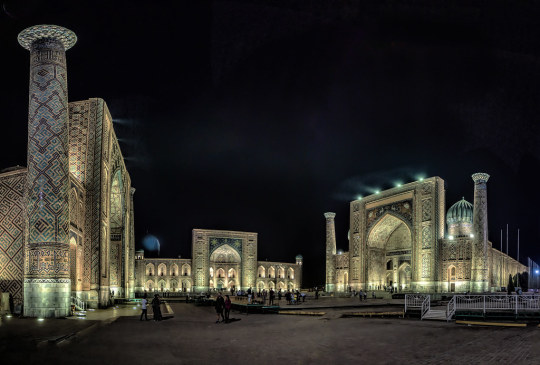
the Registan square by night by Wim van de Meerendonk, loving nature Choosing from 1800 pictures will be a difficult task, although I most of the time know which subjects I want to post on my flickr account. One of these subjects is the Registan (en.wikipedia.org/wiki/Registan) in Samarkand. Samarkand (see www.flickr.com/photos/115540984@N02/48929016568/in/datepo...) is the stunning highlight of all the cultural things I have seen during my trip, although in Uzbekistan more of these cities show the immense richness of ages long gone (15th century). The big square is on three side flanked with big madrasahs, that once served as universities and schools. Nowadays they serve as shops that sell all sorts of crap. Inside the madrasahs there can be other buildings and gardens. Inside the Ulugh Beg Madrasa, that you can see on the left, there is the most splendid interior that I have ever seen, and I will post that later. Prepare for it, because unless you go for yourselves, there is not much that competes with those dazzling mosaics. 20 September I came back from my journey over a part of the Silk Road to and through Central Asia. 4 months of traveling through 14 countries (Germany, Austria, Hungary, Romania, Turkey, Georgia, Azerbaijan, Kazakhstan, Kirgizstan, Tajikistan, Uzbekistan, Turkmenistan, Iran) before I flew home from Teheran. An impressive journey in countries that are extremely beautiful, with lovely and welcoming people and diverse cultures and history. Intense traveling with more than 20000 kilometers in our mobile home on sometimes roads that hardly could be called that way. We saw many villages and cities (some wonderful, others very ugly), countries that are transforming from the old Soviet era into something more related to older cultures and the way people live, often funded by oil readily available around the Caspian sea. We saw the amazing mountains south of the Black Sea, the wonderful Caucasus, and the high mountains in the far east close to China with peaks over 7000 meter, and not to forget the (Bulgarian) Alps! We crossed the great steppe of Kazakhstan. a drive of at least 5000 km, the remnants of lake Aral, once one of the biggest lakes of the world, saw a rocket launch from Baikonur (this little part is Russian owned), we crossed many high mountains passes, and drove the breathtaking canyon that comes from the Pamir, beginning at ca 4500 meter, and going down for ca. 400km to an altitude of 1300 meter, driving for 100's of kilometers along the Afghan border. And then the numerous lakes with all sorts of different colors from deep cobalt blue to turquoise, and one rare spectacle in Turkmenistan where a gas crater is burning already for more than 40 years. And finally and certainly not the least to mention an enormous amount of wonderful, hospitable and welcoming people. The woman often dressed in wonderful dresses, and bringing a lot of color in the streets of almost of all countries we visited. https://flic.kr/p/2i3NkqM
2 notes
·
View notes
Text
Registan - The heart of the ancient city of the Timurid Empire in Samarkand
Registan – The heart of the ancient city of the Timurid Empire in Samarkand
The name Rēgistan means “sandy place” or “desert” in Persian. The Registan was a public square, where people gathered to hear royal proclamations and a place of public executions. It is framed by three Islamic schools of distinctive Islamic architecture. The Ulugh Beg Madrasah (1417–1420), the Tilya-Kori Madrasah (1646–1660) and the Sher-Dor Madrasah (1619–1636).
The Ulugh Beg Madrasah, built by…
View On WordPress
0 notes
Photo

#Registan#ancient city of Samarkand#Timurid dynasty#Uzbekistan#madrasahs#Ulugh Beg Madrasah#Tilya-Kori Madrasah#Sher-Dor Madrasah#Ulugh Beg#Yalangtush Bakhodur#architecture
0 notes
Photo
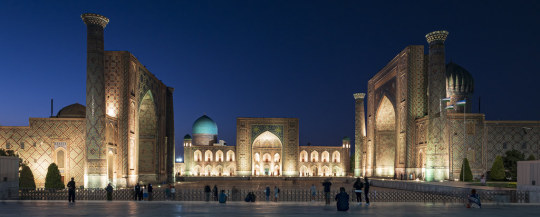
Registan Samarkand, Uzbekistan by kalakeli From left to right 3 Madrasa are facing each other: Ulugh Beg Madrasah, Tilya-Kori Madrasah and Sher-Dor Madrasah Since the 10th century a madrasah is an educational institution in which Islam was taught. The years of education depended on what you wanted to become. Von links nach rechts stehen sich 3 Medresen frontal gegenüber: Ulugʻbek-Madrasa, Tilla-Kori-Madrasa und Sher-Dor-Madrasa Eine Medresse ist seit dem 10. Jahrhundert die Bezeichnung für religiöse Schulen, in denen der Koran bzw. Islamwissenschaften unterrichtet wurde. Wie viele Jahre die Ausbildung dauerte hing von dem Ziel der Ausbildung ab. https://flic.kr/p/2nRF8Ys
0 notes
Photo
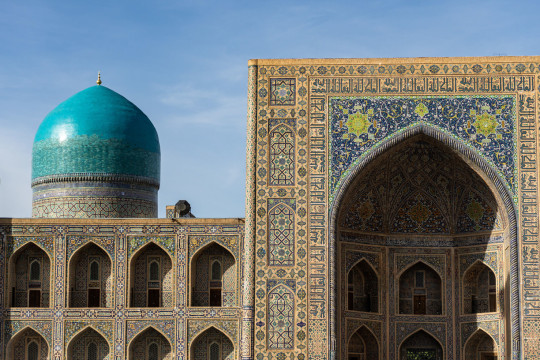
This is Ulugh Beg Madrasah and it is a part of the Registan. It was built from 1417 to 1420 by Ulugh Beg during the Timurid dynasty. Ulugh Beg was a scientist on the throne. He was a prominent astronomer of his times and was a big promoter of education, science and art. It is a religious educational institution in Samarkand. It was among the best universities of the Muslim Orient in the 15th Century CE. Address – Corner of Registan & Toshkent Opening Hours – 8am – 7pm (April – September) 9am – 5pm (October – March) Note – If there is an event on in the Registan Square it may close earlier than expected Price – 30,000 Som p/p #Uzbekistan #Samarkand #CentralAsia Discovered at Samarkand, Samarkand, Uzbekistan. See more at Trover
0 notes
Photo
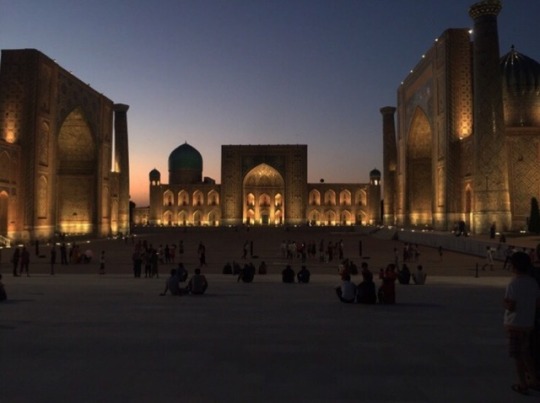
The Registan and its three madrasahs. From left to right: Ulugh Beg Madrasah, Tilya-Kori Madrasah and Sher-Dor Madrasah.
22 notes
·
View notes
Text
Ulugh Beg
Mīrzā Muhammad Tāraghay bin Shāhrukh (Chagatay/Persian: میرزا محمد طارق بن شاہ رخ) better known as Ulugh Beg ( الغ بیگ) (March 22, 1394 in Sultaniyeh (Persia) – October 27, 1449 (Samarkand)) was a Timurid ruler as well as an astronomer, mathematician and sultan. His commonly known name is not truly a personal name, but rather a moniker, which can be loosely translated as "Great Ruler" or "Patriarch Ruler" and was the Turkic equivalent of Timur's Perso-Arabic title Amīr-e Kabīr.[1] His real name was Mīrzā Mohammad Tāraghay bin Shāhrokh. Ulugh Beg was also notable for his work in astronomy-related mathematics, such as trigonometry and spherical geometry. He built the great Ulugh Beg Observatory in Samarkand between 1424 and 1429. It was considered by scholars to have been one of the finest observatories in the Islamic world at the time and the largest in Central Asia.[2] He built the Ulugh Beg Madrasah (1417–1420) in Samarkand and Bukhara, transforming the cities into cultural centers of learning in Central Asia.[3] He was also a mathematics genius of the 15th century — albeit his mental aptitude was perseverance rather than any unusual endowment of intellect.[4] His Observatory is situated in Samarkand which is in Uzbekistan. He ruled Uzbekistan, Tajikistan, Turkmenistan, Kyrgyzstan, and southern Kazakhstan for almost half a century from 1411 to 1449 and occupied the Herat province in Afghanistan for a short time in 1448.
Early life
He was a grandson of the great conqueror, Timur (Tamerlane) (1336–1405), and the oldest son of Shah Rukh, both of whom came from the Turkicized[5] Barlas tribe of Transoxiana (now Uzbekistan). His mother was a Persian noblewoman named Goharshad. Ulugh Beg was born in Sultaniyeh in Persia during Timur's invasion. As a child he wandered through a substantial part of the Middle East and India as his grandfather expanded his conquests in those areas. After Timur's death, however, and the accession of Ulugh Beg's father to much of the Timurid Empire, he settled in Samarkand, which had been Timur's capital. After Shah Rukh moved the capital to Herat (in modern Afghanistan), sixteen-year-old Ulugh Beg became his governor in Samarkand in 1409. In 1411, he became the sovereign ruler of the whole Mavarannahr khanate.
Science
The teenaged ruler set out to turn the city into an intellectual center for the empire. Between 1417 and 1420, he built a madrasa ("university" or "institute") on Registan Square in Samarkand (currently in Uzbekistan), and he invited numerous Islamic astronomers and mathematicians to study there. The madrasa building still survives. Ulugh Beg's most famous pupil in astronomy was Ali Qushchi (died in 1474). He was also famous in the fields of medicine and poetry. He used to debate with other poets, socials regarding the contemporary issues. He liked to debate in a poetic style, called "Bahribayt" among local poets. According to the medical book "Mashkovskiy" which is in Russian language, Ulugh Beg discovered the mixture of alcohol with garlic, apparently preserving it to help treat conditions like diarrhea, headache, stomachache, intestine illnesses. He also offered advice for newly married couples: Indicating recipes contains nuts, dried apricot, dried grape etc. that he claimed to be useful to increase men`s virility. This recipe has been given in Ibn Sina`s books also.
Astronomy
His own particular interests concentrated on astronomy, and, in 1428, he built an enormous observatory, called the Gurkhani Zij, similar to Tycho Brahe's later Uraniborg as well as Taqi al-Din's observatory in Istanbul. Lacking telescopes to work with, he increased his accuracy by increasing the length of his sextant; the so-called Fakhri sextant had a radius of about 36 meters (118 ft) and the optical separability of 180" (seconds of arc). Using it, he compiled the 1437 Zij-i-Sultani of 994 stars, generally considered[who?] the greatest star catalogue between those of Ptolemy and Brahe, a work that stands alongside Abd al-Rahman al-Sufi's Book of Fixed Stars. The serious errors which he found in previous Arabian star catalogues (many of which had simply updated Ptolemy's work, adding the effect of precession to the longitudes) induced him to redetermine the positions of 992 fixed stars, to which he added 27 stars from Abd al-Rahman al-Sufi's catalogue Book of Fixed Stars from the year 964, which were too far south for observation from Samarkand. This catalogue, one of the most original of the Middle Ages, was first edited by Thomas Hyde at Oxford in 1665 under the title Tabulae longitudinis et latitudinis stellarum fixarum ex observatione Ulugbeighi and reprinted in 1767 by G. Sharpe. More recent editions are those by Francis Baily in 1843 in vol. xiii of the Memoirs of the Royal Astronomical Society and by Edward Ball Knobel in Ulugh Beg's Catalogue of Stars, Revised from all Persian Manuscripts Existing in Great Britain, with a Vocabulary of Persian and Arabic Words (1917).
In 1437, Ulugh Beg determined the length of the sidereal year as 365.2570370...d = 365d 6h 10m 8s (an error of +58 seconds). In his measurements within many years he used a 50 m high gnomon. This value was improved by 28 seconds in 1525 by Nicolaus Copernicus, who appealed to the estimation of Thabit ibn Qurra (826–901), which had an error of +2 seconds. However, Beg later measured another more precise value as 365d 5h 49m 15s, which has an error of +25 seconds, making it more accurate than Copernicus' estimate which had an error of +30 seconds. Beg also determined the Earth's axial tilt as 23.52 degrees, which remained the most accurate measurement for hundreds of years. It was more accurate than later measurements by Copernicus and Tycho Brahe.[6]
Mathematics
In mathematics, Ulugh Beg wrote accurate trigonometric tables of sine and tangent values correct to at least eight decimal places.
Death
Ulugh Beg's scientific expertise was not matched by his skills in governance. When he heard of the death of his father Shahrukh Mirza, Ulugh Beg went to Balkh, where he heard that his nephew Ala-ud-Daulah Mirza bin Baysonqor, son of Ulugh's brother Baysonqor, had claimed the emirship of the Timurid Empire in Herat. Consequently Ulugh Beg marched against Ala-ud-Daulah and met him in battle at Morghab. Having won this battle, Ulugh Beg advanced toward Herat and massacred its people in 1448, but Ala-ud-Daulah's brother Mirza Abul-Qasim Babur bin Baysonqor came to his aid, defeating Ulugh Beg. Ulugh Beg retreated to Balkh, where he found that its governor, his oldest son Abdal-Latif Mirza, had rebelled against him. Another civil war ensued. Within two years, he was beheaded by the order of his own eldest son while on his way to Mecca.[7] Eventually, his reputation was rehabilitated by his nephew, Abdallah Mirza (1450–1451), who placed Ulugh Beg's remains in the mausoleum of Timur in Samarkand, where they were found by archeologists in 1941.
Legacy
The crater, Ulugh Beigh, on the Moon, was named after him by the German astronomer Johann Heinrich von Mädler on his 1830 map of the Moon.
2439 Ulugbek, an main-belt asteroid which were discovered on 21 August 1977 by N. Chernykh at Nauchnyj, was named after him.
Exhumation
Soviet anthropologist Mikhail M. Gerasimov reconstructed the face of Ulugh Beg. Like Timurlane, Ulugh Beg is close to the Mongoloid type with slightly Europoid features.[8][9]
0 notes
Text
Ulugh Beg
Mīrzā Muhammad Tāraghay bin Shāhrukh (Chagatay/Persian: میرزا محمد طارق بن شاہ رخ) better known as Ulugh Beg ( الغ بیگ) (March 22, 1394 in Sultaniyeh (Persia) – October 27, 1449 (Samarkand)) was a Timurid ruler as well as an astronomer, mathematician and sultan. His commonly known name is not truly a personal name, but rather a moniker, which can be loosely translated as "Great Ruler" or "Patriarch Ruler" and was the Turkic equivalent of Timur's Perso-Arabic title Amīr-e Kabīr.[1] His real name was Mīrzā Mohammad Tāraghay bin Shāhrokh. Ulugh Beg was also notable for his work in astronomy-related mathematics, such as trigonometry and spherical geometry. He built the great Ulugh Beg Observatory in Samarkand between 1424 and 1429. It was considered by scholars to have been one of the finest observatories in the Islamic world at the time and the largest in Central Asia.[2] He built the Ulugh Beg Madrasah (1417–1420) in Samarkand and Bukhara, transforming the cities into cultural centers of learning in Central Asia.[3] He was also a mathematics genius of the 15th century — albeit his mental aptitude was perseverance rather than any unusual endowment of intellect.[4] His Observatory is situated in Samarkand which is in Uzbekistan. He ruled Uzbekistan, Tajikistan, Turkmenistan, Kyrgyzstan, and southern Kazakhstan for almost half a century from 1411 to 1449 and occupied the Herat province in Afghanistan for a short time in 1448.
Early life
He was a grandson of the great conqueror, Timur (Tamerlane) (1336–1405), and the oldest son of Shah Rukh, both of whom came from the Turkicized[5] Barlas tribe of Transoxiana (now Uzbekistan). His mother was a Persian noblewoman named Goharshad. Ulugh Beg was born in Sultaniyeh in Persia during Timur's invasion. As a child he wandered through a substantial part of the Middle East and India as his grandfather expanded his conquests in those areas. After Timur's death, however, and the accession of Ulugh Beg's father to much of the Timurid Empire, he settled in Samarkand, which had been Timur's capital. After Shah Rukh moved the capital to Herat (in modern Afghanistan), sixteen-year-old Ulugh Beg became his governor in Samarkand in 1409. In 1411, he became the sovereign ruler of the whole Mavarannahr khanate.
Science
The teenaged ruler set out to turn the city into an intellectual center for the empire. Between 1417 and 1420, he built a madrasa ("university" or "institute") on Registan Square in Samarkand (currently in Uzbekistan), and he invited numerous Islamic astronomers and mathematicians to study there. The madrasa building still survives. Ulugh Beg's most famous pupil in astronomy was Ali Qushchi (died in 1474). He was also famous in the fields of medicine and poetry. He used to debate with other poets, socials regarding the contemporary issues. He liked to debate in a poetic style, called "Bahribayt" among local poets. According to the medical book "Mashkovskiy" which is in Russian language, Ulugh Beg discovered the mixture of alcohol with garlic, apparently preserving it to help treat conditions like diarrhea, headache, stomachache, intestine illnesses. He also offered advice for newly married couples: Indicating recipes contains nuts, dried apricot, dried grape etc. that he claimed to be useful to increase men`s virility. This recipe has been given in Ibn Sina`s books also.
Astronomy
His own particular interests concentrated on astronomy, and, in 1428, he built an enormous observatory, called the Gurkhani Zij, similar to Tycho Brahe's later Uraniborg as well as Taqi al-Din's observatory in Istanbul. Lacking telescopes to work with, he increased his accuracy by increasing the length of his sextant; the so-called Fakhri sextant had a radius of about 36 meters (118 ft) and the optical separability of 180" (seconds of arc). Using it, he compiled the 1437 Zij-i-Sultani of 994 stars, generally considered[who?] the greatest star catalogue between those of Ptolemy and Brahe, a work that stands alongside Abd al-Rahman al-Sufi's Book of Fixed Stars. The serious errors which he found in previous Arabian star catalogues (many of which had simply updated Ptolemy's work, adding the effect of precession to the longitudes) induced him to redetermine the positions of 992 fixed stars, to which he added 27 stars from Abd al-Rahman al-Sufi's catalogue Book of Fixed Stars from the year 964, which were too far south for observation from Samarkand. This catalogue, one of the most original of the Middle Ages, was first edited by Thomas Hyde at Oxford in 1665 under the title Tabulae longitudinis et latitudinis stellarum fixarum ex observatione Ulugbeighi and reprinted in 1767 by G. Sharpe. More recent editions are those by Francis Baily in 1843 in vol. xiii of the Memoirs of the Royal Astronomical Society and by Edward Ball Knobel in Ulugh Beg's Catalogue of Stars, Revised from all Persian Manuscripts Existing in Great Britain, with a Vocabulary of Persian and Arabic Words (1917).
In 1437, Ulugh Beg determined the length of the sidereal year as 365.2570370...d = 365d 6h 10m 8s (an error of +58 seconds). In his measurements within many years he used a 50 m high gnomon. This value was improved by 28 seconds in 1525 by Nicolaus Copernicus, who appealed to the estimation of Thabit ibn Qurra (826–901), which had an error of +2 seconds. However, Beg later measured another more precise value as 365d 5h 49m 15s, which has an error of +25 seconds, making it more accurate than Copernicus' estimate which had an error of +30 seconds. Beg also determined the Earth's axial tilt as 23.52 degrees, which remained the most accurate measurement for hundreds of years. It was more accurate than later measurements by Copernicus and Tycho Brahe.[6]
Mathematics
In mathematics, Ulugh Beg wrote accurate trigonometric tables of sine and tangent values correct to at least eight decimal places.
Death
Ulugh Beg's scientific expertise was not matched by his skills in governance. When he heard of the death of his father Shahrukh Mirza, Ulugh Beg went to Balkh, where he heard that his nephew Ala-ud-Daulah Mirza bin Baysonqor, son of Ulugh's brother Baysonqor, had claimed the emirship of the Timurid Empire in Herat. Consequently Ulugh Beg marched against Ala-ud-Daulah and met him in battle at Morghab. Having won this battle, Ulugh Beg advanced toward Herat and massacred its people in 1448, but Ala-ud-Daulah's brother Mirza Abul-Qasim Babur bin Baysonqor came to his aid, defeating Ulugh Beg. Ulugh Beg retreated to Balkh, where he found that its governor, his oldest son Abdal-Latif Mirza, had rebelled against him. Another civil war ensued. Within two years, he was beheaded by the order of his own eldest son while on his way to Mecca.[7] Eventually, his reputation was rehabilitated by his nephew, Abdallah Mirza (1450–1451), who placed Ulugh Beg's remains in the mausoleum of Timur in Samarkand, where they were found by archeologists in 1941.
Legacy
The crater, Ulugh Beigh, on the Moon, was named after him by the German astronomer Johann Heinrich von Mädler on his 1830 map of the Moon.
2439 Ulugbek, an main-belt asteroid which were discovered on 21 August 1977 by N. Chernykh at Nauchnyj, was named after him.
Exhumation
Soviet anthropologist Mikhail M. Gerasimov reconstructed the face of Ulugh Beg. Like Timurlane, Ulugh Beg is close to the Mongoloid type with slightly Europoid features.[8][9]
0 notes
Text
Ulugh Beg
Mīrzā Muhammad Tāraghay bin Shāhrukh (March 22, 1394 in Sultaniyeh (Persia) – October 27, 1449 (Samarkand)) was a Timurid ruler as well as an astronomer, mathematician and sultan. His commonly known name is not truly a personal name, but rather a moniker, which can be loosely translated as "Great Ruler" or "Patriarch Ruler" and was the Turkic equivalent of Timur's Perso-Arabic title Amīr-e Kabīr.[1] His real name was Mīrzā Mohammad Tāraghay bin Shāhrokh. Ulugh Beg was also notable for his work in astronomy-related mathematics, such as trigonometry and spherical geometry.
He built the great Ulugh Beg Observatory in Samarkand between 1424 and 1429. It was considered by scholars to have been one of the finest observatories in the Islamic world at the time and the largest in Central Asia.[2] He built the Ulugh Beg Madrasah (1417–1420) in Samarkand and Bukhara, transforming the cities into cultural centers of learning in Central Asia.[3] He was also a mathematics genius of the 15th century — albeit his mental aptitude was perseverance rather than any unusual endowment of intellect.[4] His Observatory is situated in Samarkand which is in Uzbekistan. He ruled Uzbekistan, Tajikistan, Turkmenistan, Kyrgyzstan, and southern Kazakhstan for almost half a century from 1411 to 1449 and occupied the Herat province in Afghanistan for a short time in 1448.
Early life
He was a grandson of the great conqueror, Timur (Tamerlane) (1336–1405), and the oldest son of Shah Rukh, both of whom came from the Turkicized[5] Barlas tribe of Transoxiana (now Uzbekistan). His mother was a Persian noblewoman named Goharshad. Ulugh Beg was born in Sultaniyeh in Persia during Timur's invasion. As a child he wandered through a substantial part of the Middle East and India as his grandfather expanded his conquests in those areas. After Timur's death, however, and the accession of Ulugh Beg's father to much of the Timurid Empire, he settled in Samarkand, which had been Timur's capital. After Shah Rukh moved the capital to Herat (in modern Afghanistan), sixteen-year-old Ulugh Beg became his governor in Samarkand in 1409. In 1411, he became the sovereign ruler of the whole Mavarannahr khanate.
Science
The teenaged ruler set out to turn the city into an intellectual center for the empire. Between 1417 and 1420, he built a madrasa ("university" or "institute") on Registan Square in Samarkand (currently in Uzbekistan), and he invited numerous Islamic astronomers and mathematicians to study there. The madrasa building still survives. Ulugh Beg's most famous pupil in astronomy was Ali Qushchi (died in 1474). He was also famous in the fields of medicine and poetry. He used to debate with other poets, socials regarding the contemporary issues. He liked to debate in a poetic style, called "Bahribayt" among local poets. According to the medical book "Mashkovskiy" which is in Russian language, Ulugh Beg discovered the mixture of alcohol with garlic, apparently preserving it to help treat conditions like diarrhea, headache, stomachache, intestine illnesses. He also offered advice for newly married couples: Indicating recipes contains nuts, dried apricot, dried grape etc. that he claimed to be useful to increase men`s virility. This recipe has been given in Ibn Sina`s books also.
Astronomy
His own particular interests concentrated on astronomy, and, in 1428, he built an enormous observatory, called the Gurkhani Zij, similar to Tycho Brahe's later Uraniborg as well as Taqi al-Din's observatory in Istanbul. Lacking telescopes to work with, he increased his accuracy by increasing the length of his sextant; the so-called Fakhri sextant had a radius of about 36 meters (118 ft) and the optical separability of 180" (seconds of arc). Using it, he compiled the 1437 Zij-i-Sultani of 994 stars, generally considered[who?] the greatest star catalogue between those of Ptolemy and Brahe, a work that stands alongside Abd al-Rahman al-Sufi's Book of Fixed Stars. The serious errors which he found in previous Arabian star catalogues (many of which had simply updated Ptolemy's work, adding the effect of precession to the longitudes) induced him to redetermine the positions of 992 fixed stars, to which he added 27 stars from Abd al-Rahman al-Sufi's catalogue Book of Fixed Stars from the year 964, which were too far south for observation from Samarkand. This catalogue, one of the most original of the Middle Ages, was first edited by Thomas Hyde at Oxford in 1665 under the title Tabulae longitudinis et latitudinis stellarum fixarum ex observatione Ulugbeighi and reprinted in 1767 by G. Sharpe. More recent editions are those by Francis Baily in 1843 in vol. xiii of the Memoirs of the Royal Astronomical Society and by Edward Ball Knobel in Ulugh Beg's Catalogue of Stars, Revised from all Persian Manuscripts Existing in Great Britain, with a Vocabulary of Persian and Arabic Words (1917).
In 1437, Ulugh Beg determined the length of the sidereal year as 365.2570370...d = 365d 6h 10m 8s (an error of +58 seconds). In his measurements within many years he used a 50 m high gnomon. This value was improved by 28 seconds in 1525 by Nicolaus Copernicus, who appealed to the estimation of Thabit ibn Qurra (826–901), which had an error of +2 seconds. However, Beg later measured another more precise value as 365d 5h 49m 15s, which has an error of +25 seconds, making it more accurate than Copernicus' estimate which had an error of +30 seconds. Beg also determined the Earth's axial tilt as 23.52 degrees, which remained the most accurate measurement for hundreds of years. It was more accurate than later measurements by Copernicus and Tycho Brahe.[6]
Mathematics
In mathematics, Ulugh Beg wrote accurate trigonometric tables of sine and tangent values correct to at least eight decimal places.
Death
Ulugh Beg's scientific expertise was not matched by his skills in governance. When he heard of the death of his father Shahrukh Mirza, Ulugh Beg went to Balkh, where he heard that his nephew Ala-ud-Daulah Mirza bin Baysonqor, son of Ulugh's brother Baysonqor, had claimed the emirship of the Timurid Empire in Herat. Consequently Ulugh Beg marched against Ala-ud-Daulah and met him in battle at Morghab. Having won this battle, Ulugh Beg advanced toward Herat and massacred its people in 1448, but Ala-ud-Daulah's brother Mirza Abul-Qasim Babur bin Baysonqor came to his aid, defeating Ulugh Beg. Ulugh Beg retreated to Balkh, where he found that its governor, his oldest son Abdal-Latif Mirza, had rebelled against him. Another civil war ensued. Within two years, he was beheaded by the order of his own eldest son while on his way to Mecca.[7] Eventually, his reputation was rehabilitated by his nephew, Abdallah Mirza (1450–1451), who placed Ulugh Beg's remains in the mausoleum of Timur in Samarkand, where they were found by archeologists in 1941.
Legacy
The crater, Ulugh Beigh, on the Moon, was named after him by the German astronomer Johann Heinrich von Mädler on his 1830 map of the Moon.
2439 Ulugbek, an main-belt asteroid which were discovered on 21 August 1977 by N. Chernykh at Nauchnyj, was named after him.
Exhumation
Soviet anthropologist Mikhail M. Gerasimov reconstructed the face of Ulugh Beg. Like Timurlane, Ulugh Beg is close to the Mongoloid type with slightly Europoid features.[8][9]
0 notes
Text
撒馬爾罕 – 文化的十字路口
撒馬爾罕(Samarkand)
撒馬爾罕是一個在從西元前七世紀就存在於古絲路上的古鎮,位在古中國以及地中海之間。因其地理位置與歷史背景,撒馬爾罕也曾是中西文明交匯之處,因此於 2001 年,聯合國教科文組織(UNESCO)以『站在中西文化十字路口的撒馬爾罕』之名,將該市列入世界遺產名錄。
我們在烏茲別克的第一站『撒馬爾罕』共待了三天四夜,以下是我們拜訪過的景點以及照片。
帖木兒陵 (Gur-e-Amir)
帖木兒陵位在烏茲別克的撒馬爾罕,是用來紀念帖木兒帝國的奠��人帖木兒。其帝國曾征服了西亞、南亞和中亞,並統治長達約有四個世紀的時間。
當我們在付錢買門票時,賣票大媽問了一句『你等會要照相嗎?』這時我們才知道,在帖木兒陵裡頭要照相,得多花個 5,000 烏茲別克索姆買的照相券。
Gur-e-Amir, mausoleum of the Asian conqueror Timur 帖木兒陵
Gur-e-Amir, mausoleum of the Asian conqueror Timur 帖木兒陵
Gur-e-Amir, mausoleum of the Asian conqueror Timur 帖木兒陵
Gur-e-Amir, mausoleum of the Asian conqueror Timur 帖木兒陵
Gur-e-Amir, mausoleum of the Asian conqueror Timur 帖木兒陵
雷吉斯坦廣場 (The Registan)
雷吉斯坦廣場曾在帖木兒帝國時期是撒馬爾罕的市中心。根據維基百科,Registan(雷吉斯坦)在波斯語中是沙漠之意。雷吉斯坦是由三座伊斯蘭學校加上中央的大廣場所組成的。其中三座伊斯蘭學校由左至右為 Ulugh Beg (1417–1420), Tilya-Kori (1646–1660) 與 Sher-Dor (1619–1636)。
欲入裡頭參觀,當然得先買門票。而這裡的票分白天票與星空票兩種,不同票價。對於外國遊客而言,白天票 7 美金,星空票 5 美金。然而我們表示身上沒有美金,所以只付了 21,000 烏茲別克索姆。至於為何會這樣?請讀這篇關於烏茲別克索姆兩三事。
The Registan: a public square and three Madrasahs: Ulugh Beg Madrasah (left), Tilya-Kori Madrasah (centre), and Sher-Dor Madrasah (right) 雷吉斯坦廣場與三座伊斯蘭學校:Ulugh Beg(左),Tilya-Kori(中)以及 Sher-Dor(右)。
The Registan at sunset 黃昏時分的雷吉斯坦廣場
Sher-Dor Medressa. The tiger mosaics on the face of the madrassa are interesting. Sher-Dor 伊斯蘭學校,���在雷吉斯坦廣場的右側。
Sophisticated gold ceiling of the Tilla-Kari Medressa Tilla-Kari 伊斯蘭學校的金碧輝煌圓頂
Tiling of the Registan 雷吉斯坦廣場精緻的外牆貼磚
比比哈寧清真寺 (Bibi-Khanym Mosque)
比比哈寧清真寺曾在 15 世紀時是伊斯蘭世界最宏偉的清真寺,其主廳圓頂高達40公尺。然而當我們走進主廳一瞧,真心覺得這兒的確需要好好地整修一番了,四處破敗不堪的景象實在難以與其輝煌的過往的印象連結起來,不僅如此,我甚至覺得要來個地震,整個清真寺垮了我都不會意外。
如同帖木兒陵,想在比比哈寧清真寺照相,買個照相券先。
Facade of the Bibi-Khanym Mosque 比比哈寧清真寺
Bibi-Khanym Mosque 比比哈寧清真寺
The cupola of Bibi-Khanym Mosque’s main chamber is 40 metres high. 比比哈寧清真寺的主廳圓頂高達40公尺。
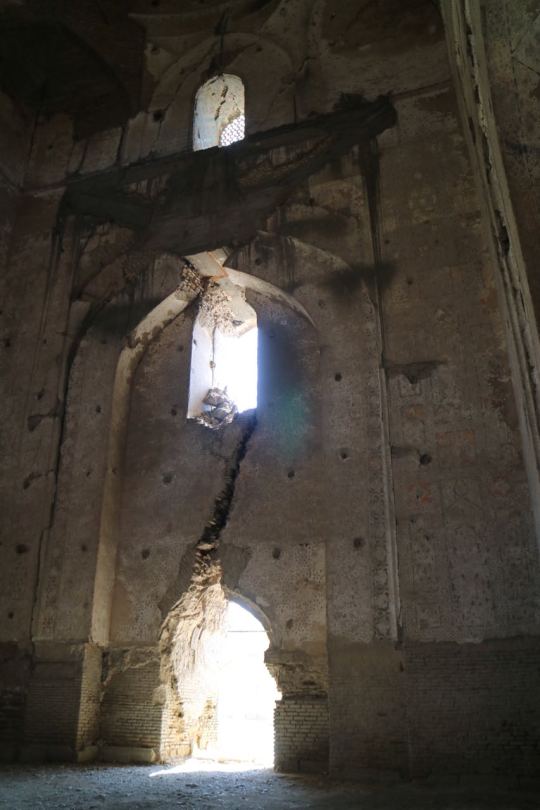
Bibi-Khanym Mosque is in need of some serious restoration work. 比比哈寧清真寺真的需要整修工程。
哈札特希茲爾清真寺 (Hazrat-Hizr Mosque)
聽說哈札特希茲爾清真寺是撒馬爾罕非常漂亮的清真寺之一,所以理所當然我們想去一探究竟。然而,當我們實際來到這裡之前,烏茲別克的強人(前)總統過世了,而他也被葬在家鄉撒馬爾罕。當我們一到哈札特希茲爾清真寺,還覺得納悶一個清真寺戒備如此森嚴又如此熱門?外頭有多名警察且人們在外頭排隊等著進清真寺。後來才知道該清真寺在這段時間都用作供烏茲別克民眾弔念前總統的場地了。所以我們毫無頭緒地隨著眾多民眾參與了一場弔念儀式,清真寺倒是沒看成。
Hazrat-Hizr Mosque 哈札特希茲爾清真寺
往布哈拉 (Bukhara) 的火車票
撒馬爾罕之後的下一個目的地是布哈拉,有鑒於咱們在哈薩克買火車票遇到些困難(見哈薩克火車),我們提前一天去了趟位在新市中心的火車票售票處預先買票,為的是可以順利在我們想要的時間抵達。然而因為不懂也不了解,透過售票處的服務台詢問了車票相關事宜,結果被索討 2,000 烏茲別克索姆。其實各位如果已經清楚知道何時要去哪兒,可以直接跳過服務台去售票窗口詢問與購票。
0 notes
Photo

Ulugh Beg Madrasah (1417–1420) , built by Ulugh Beg during the Timurid Empire era of Timur—Tamerlane, has an imposing iwan with a lancet-arch pishtaq or portal facing the square. The corners are flanked by high minarets. The mosaic panel over the iwan's entrance arch is decorated by geometrical stylized ornaments. . The square courtyard includes a mosque and lecture rooms, and is fringed by the dormitory cells in which students lived. There are deep galleries along the axes. Originally the Ulugh Beg Madrasah was a two-storied building with four domed darskhonas (lecture rooms) at the corners. . The Ulugh Beg Madrasah was one of the best clergy universities of the Muslim Orient in the 15th Century CE. Abdul-Rahman Jami, the great Persian poet, scholar, mystic, scientist and philosopher studied at the madrasah.[1] Ulugh Beg himself gave lectures there. During Ulugh Beg's government the madrasah was a centre of learning. . #ulugbek #registan #samarkand #uzbekistan #centralasia #traveladdict #wishlist #bucketlist #lpfanphoto #travelingtheworld #atlas #world #bestplacestogo #beautifuldestinations #dreamplaces #speechlessplaces #girlswhowander #glt #gltLove #girlslovetravel #neverstopexploring #wanderlust #lelsinsamarkand #lelsinuzbekista https://www.instagram.com/p/BzBZ-VphE-2/?igshid=1vsay6sjfxodd
#ulugbek#registan#samarkand#uzbekistan#centralasia#traveladdict#wishlist#bucketlist#lpfanphoto#travelingtheworld#atlas#world#bestplacestogo#beautifuldestinations#dreamplaces#speechlessplaces#girlswhowander#glt#gltlove#girlslovetravel#neverstopexploring#wanderlust#lelsinsamarkand#lelsinuzbekista
0 notes
Video
youtube
Visit to Samarkand City - Samarkand Tours Operator – 998998520077
Visit to Samarkand City
This is the best Samarkand City tour for visiting this great city in just one day. Of all of the UNESCO World Heritage Sites in Uzbekistan, Samarkand is the most majestic: the squares were once filled with merchants from far and wide, and the halls of these grand buildings were walked by some of most important scholars of their time. Start with the Ulugbek Observatory, a museum dedicated to the achievements and work of scientists from generations past. Shahi-Zinda, a winding alley lined with intricately-decorated mausoleums, is the next stop, followed by Bibi-Khanum Mosque, still impressive even though it has laid in ruins for centuries. Registan Square is the crown jewel of Samarkand, a symbol of Samarkand’s history as a trade and cultural center on the Silk Road. Finish up the tour with stops at Siab Bazaar, perfect for wandering among vendors of dried fruits, colorful cloths, and freshly-baked bread, and Gur-Emir Mausoluem, the final resting place of Timur, one of the greatest rulers of Central Asia. For just one day, you’ll be back in the time of the Silk Road, walking the streets of Samarkand and seeing the monuments of this great city.
Samarkand is situated in the valley of the river Zerafshan. It is the second largest city of Uzbekistan and is of the same age as the city of Babylon or Rome.
The history of Samarkand is about 2,750 years old and has witnessed many upheavals during the times of Alexander the Great, the Arabic Conquest, Genghis-Khan Conquest and lastly Tamerlane’s. Hence, the culture of Samarkand was developed and mixed together with the Iranian, Indian, Mongolian and a bit of the Western and Eastern cultures.
Majestic and beautiful city Samarkand has a marvelous and attractive power. Poets and historians of the past called it “Rome of the East, The beauty of sublunary countries, The pearl of the Eastern Muslim World”. Its advantageous geographical position in the Zarafshan valley puts Samarkand to the first place among cities of Central Asia.
Registan
Registan which consists of three distinct madrasahs (Islamic school) is the main and standout tourist attraction of this place.
The Ulugh Beg Madrasah
It is a religious educational institution founded by Ulugh Beg, a renowned mathematician and astronomer located at the heart of Samarkand.
Ulugh Beg Observatory
One of the best astronomy observatory built by Ulugh Beg himself where some of the renowned Islamic astronomers like Ali Qushji and Al-Kashi worked. A museum was later built besides it to honor Ulugh Beg.
Sher-Dor Madrasah
One of the madrasahs located in Registran square, it is the first to have been built in this school complex.
Tilya-Kori Madrasah
Another madrasah located in Registran square, it was the residential college for scholars studying in these madrasahs.
The Shah-i-Zinda necropolis
It is one of the necropolises situated in the north-eastern part of Samarkand housing mausoleums and ritual buildings continually being built since the 14th century.
Bibi-Khanym Mosque
One of the most important monuments in Samarkand, it is among the most magnificent mosques in Islamic world.
The Gur-e-Amir Mausoleum
The tomb of conqueror Timur, it is an important place to see the Persian-Mongolian architecture.
The Siyob Bazaar
This bazaar is a buzzing hub for all daily necessities of people of Samarkand like vegetables, dairy products, meats et cetera. You can just stroll through the corners and get a sense of the local lifestyle.
Khazret-Khyzr Mosque
It is one of the oldest Muslim religious buildings in Samarkand built in 8th century.
Plus code:
86CX+GP Tashkent, Uzbekistan
Address:
Samarkand Tours Operator
Yunusabad 19-35-87
Tashkent ,100114,
Uzbekistan
998998520077
https://samarkandtours.com/tour/visit-to-samarkand-city/
https://www.google.com/maps/d/u/4/viewer?mid=1AbQ6S5o7i-KAuq-ZizeUFIem8SXVxuYu&ll=39.651106847409025%2C66.9874396&z=13
Video on youtube:
https://youtu.be/GaYM-GzoAqQ
Searching keyword:
Visit to Samarkand city
#VisittoSamarkandcity
0 notes
Photo

Samarqand UZ - Registan Tilya-Kori-Madrasa 08 by Daniel Mennerich The Registan was the heart of the ancient city of Samarkand of the Timurid dynasty, now in Uzbekistan. The name Rēgistan means "Sandy place" or "desert" in Persian. The Registan was a public square, where people gathered to hear royal proclamations, heralded by blasts on enormous copper pipes called dzharchis - and a place of public executions. It is framed by three madrasahs (Islamic schools) of distinctive Islamic architecture. The three madrasahs of the Registan are: the Ulugh Beg Madrasah (1417–1420), the Tilya-Kori Madrasah (1646–1660) and the Sher-Dor Madrasah (1619–1636). Madrasah is an Arabic term meaning school. https://flic.kr/p/23SzD79
0 notes